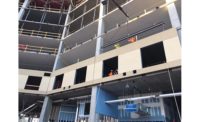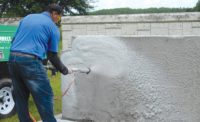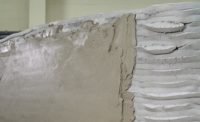Labor shortages in the construction industry continue to present serious challenges for contractors across the country, with some markets facing greater hurdles than others when it comes to finding qualified workers.
The labor squeeze is expanding interest in the use of pre-fabricated EIFS panels, which can be constructed with fewer workers and if necessary, can be built in areas with greater labor supply and shipped to construction sites.
Panelization
While the tight labor market is a key driver in the growth of pre-fabrication, also referred to as “panelization,” other factors are also driving panelization, including significant cost savings and a much faster installation time compared to field-applied EIFS. The construction season can also be extended with pre-fabricated panels when cold weather eliminates the option for field-applied EIFS. Other benefits include improved quality assurance, a reduction in the amount of scaffolding and reduced risk thanks to less jobsite congestion.
Dryvit is taking steps to make it easier for EIFS applicators to use pre-fabricated panels, providing free access to the manufacturer’s engineering department for design review and detail reviews. The company has also created three different attachment systems designed to enable easier installation of pre-fabricated panels in a variety of scenarios including renovation, construction of metal buildings and construction of new high-rise buildings.
Patrick Luciano, a senior project manager for Vergith Contracting in Las Vegas has become a leading expert in the use of pre-fabricated EIFS panels for jobs where EIFS is specified. Vergith Contracting handles a range of construction work including framing and installation of drywall, EIFS, and plaster. The company also provides painting and wall covering services.
Luciano’s embrace of pre-fabricated EIFS panels started a number of years ago and has grown stronger with each successive job. The senior project manager has seen first-hand the cost savings and accelerated installation time associated with pre-fabrication and has become an evangelist of sorts for what he says is the better way to install EIFS on a building.
The Sunrise Hospital
Luciano’s latest project with Layton Construction involves building a new tower at Sunrise Hospital in Las Vegas, a project Luciano says was tailor made for pre-fabricated panels. “The three main reasons we used pre-fabricated EIFS panels for Sunrise Hospital was to minimize site disruption, achieve significant labor savings and accelerate installation,” says Luciano.
Luciano estimates that by creating the 423 panels needed for the Sunrise Hospital job offsite, he was able to shave four months off the construction schedule and deliver labor savings of approximately 17 percent. Luciano cites other benefits to using pre-fabricated panels including the ability to install larger panels that can cover wide sections of a building façade, often spanning two floors. Luciano also believes that using pre-fabricated panels can result in a better quality installation, especially when scaffolding is needed for field-applied EIFS.
“If you’re field applying EIFS on a taller building with scaffolding, there’s always a chance that movement of the scaffolding down the face of the building is going to result in a lower quality finish,” says Luciano.
While Luciano has been a strong believer in pre-fabricated panels for years, his view hasn’t been universally held in the design and construction industry.
“We had a job a few years ago where we thought pre-fabricated panels made perfect sense but the client and their architect saw things differently,” says Luciano. “We had to convince this client and their architect that pre-fabrication was the better approach. They eventually agreed and at the end of the day, were thrilled with the faster completion time and savings attributed to panelization.”
Le Meridien Hotel
Beyond Luciano’s experience in Las Vegas, other Dryvit applicators are finding that the use of pre-fabricated panels is often necessitated by circumstances related to the job site. This was the case with the construction of the new Le Meridien Hotel in Columbus, Ohio, where the hotel’s tight footprint left little room between the edge of the building and the nearby street. Cladding the building with field applied-EIFS would have required sidewalk and road closures for an eight-month period, something city officials would not have approved.
Robert Sutton was the project manager of Reitter Stucco Co., the panel installer. “We quickly came to see the advantage of panels for this job.” Sutton says panelized systems are preferable on any project where bad weather is inevitable or where the project is over four stories high because building scaffolding past four stories “is pretty difficult. You are better off using some kind of swing stage or mast climber (with panels) for the install.”
Dryvit’s John Powers, regional sales manager for the Midwest region, points out another reason the panels were a smart choice for the Le Meridien. “The number one thing the developer wanted to achieve was critical path shell dry-in, or a weather-tight building, quickly so they could start work on the interior,” says Powers.
“There’s a big advantage to panels versus field applied EIFS because you can’t install it on just any day,” says Rob Little, the owner of Little Construction, the applicator that installed the EIFS material who spent time teaching Reitter’s two crew leaders on the installation process. “It has to be a nice, calm day and you have to do the job when there isn’t a lot of sun on the walls which could cause it to dry out too quick.”
Applied Restoration
Another recent pre-fabrication project that was driven by unique factors related to the building was the exterior cladding overhaul by Applied Restoration of a seven-story office building built in the 1960’s in Bremerton, Washington. “The building’s cement façade had small round stones embedded into the face, some as large as the size of a baseball,” says Larry White of Applied Restoration. “Some of the stones near the top of the wall started coming loose and were falling to the ground below. Thankfully no one was injured and we were able to install a sidewalk canopy to ensure safety while the renovation was undertaken.”
Applied Restoration explored the feasibility of tearing all of the stones out of the wall and recladding with EIFS but concluded this approach was too costly. Since the variable sizes of the stone cladding made it impractical to use field applied EIFS, the decision was then made to use pre-fabricated EIFS. A light gauge structure was attached to the wall of the building extending just beyond the largest stones to provide a uniform plane to which the pre-fabricated panels could be attached.
Whether it’s Las Vegas, Ohio or Washington State, pre-fabrication is on the rise and Dryvit expects this trend to continue across the country. The company is committed to providing the full support needed to make the use of pre-fabricated EIFS panels a simple choice for architects, contractors and applicators.










Report Abusive Comment